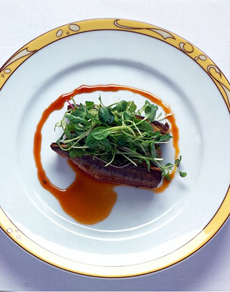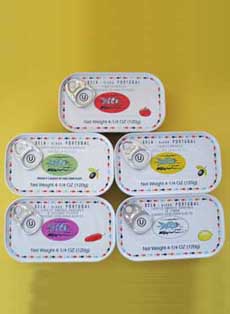PRODUCT: Sardines, Delicious & Great For You
 Serve sardines topped with cress or with other salad greens for a light lunch, first course or main dinner course. Photo courtesy Payard | NYC, which grilled fresh sardines for this rexipe. |
If you’re trying to incorporate more fish into your diet, peel back a tin of quality sardines. It’s a break from the same old can of tuna, and the right brand can be a delightful discovery.
BELA-Olhão, from the fishing community of Olhão, Portugal, has perfected the art of canning sardines. Plump, meaty and pretty, too—their silvery skins shimmer on the plate—these are gourmet sardines. The sardines are wild caught, sustainably fished off a non-industrial coast and 100% dolphin safe. They are packed within eight ours of the catch and canned in top-quality olive oil. They are certified sustainable by the Marine Stewardship Council. They’re available in plain plus delicious flavored varieties: |
|
|
Matiz, from Spain, is another top-quality brand. There’s no “fishiness” in these fine sardines. If your prior experiences with sardines have not been satisfying, give them a try. SARDINE NUTRITION & HEALTH BENEFITS Omega 3, 6 & 9. Among fish, sardines have the highest levels of omega-3, -6 and -9 essential fatty acids.They aid the body in transferring oxygen, help with muscle elasticity, brain activity and have a positive impact on the blood vessels and heart. Calcium. Sardines are super-rich in calcium: A 3.5-ounce serving has more calcium than a cup of whole milk! One 4.25-ounce tin provides 30% of your daily value. Coenzyme Q. Sardines are rich in coenzyme Q-10, plus a spate of vitamins and minerals. Coenzyme Q-10 can stave off heart disease, high blood pressure, cancer, even depression. More. Sardines are a good source of vitamin D, B12 and lean protein. Low mercury. With a mercury content of 0.016 ppm, the FDA calculates that sardines have one of the lowest levels of mercury among seafood. This may be a result of a diet that consists mainly of krill and plankton. The more kinds of other fish a species eats, the more likely it is to absorb the mercury levels of the fish that it feasts upon (which is why shark mercury levels are so high—they eat so many kinds of fish, some of which contain a high mercury content). SARDINES VS. SALMON Sardines are “the new salmon.” Now if only consumers would figure that out! Because of the move to eat more salmon, the wild fish have become less abundant, less sustainable, less nutritious and are suffering from epidemic-like outbreaks created when infected farmed salmon escape into the wild. There are numerous issues with farmed salmon—read this article in the New York Times by Taras Grescoe, author of Bottomfeeder: How to Eat Ethically in a World of Vanishing Seafood. The bottom line: Sardines are a great alternative. |
||
|
SERVING SARDINES
All sardines need—fresh or canned—is a squeeze of lemon juice and some minced parsley (and if fresh-grilled, a few drops of quality olive). The quality of Bela-Olhão’s extra virgin olive oil means that no draining is required. Sardines are simple to serve: RECIPE: SARDINE CAKES Ingredients For 4 Servings (2 Cakes Each) |
 Bela Olhao sardines in plain and flavored olive oils. Photo by Melody Lan | THE NIBBLE. |
|
|
Preparation 1. MASH the beans in a large bowl using the back of a spoon until smooth but still a bit chunky. 2. ADD sardines, cheese, pepper, 3/4 cup of the bread crumbs, egg, lemon juice, tarragon, salt, and pepper to taste and mix well to combine. Place the remaining bread crumbs on a plate. 3. SHAPE the mixture into eight 1/2-inch thick patties and coat with the remaining bread crumbs. 4. HEAT 1 tablespoon of the oil in a large nonstick skillet over medium-high heat. Cook the patties until golden brown, about 4 minutes per side. Add the remaining oil when you turn the patties. 5. SERVE with a wedge of lemon, and optional tartar sauce or ketchup for dipping. Like tuna, sardines fit in to any green salad preparation. Try this recipe for a sophisticated Sardine, Cress & Almond Salad. |
||


